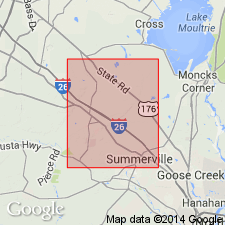
- Usage in publication:
-
- Pringletown beds*
- Modifications:
-
- First used
- Dominant lithology:
-
- Sand
- Clay
- AAPG geologic province:
-
- Atlantic Coast basin
Summary:
Informally named the Pringletown beds in the Charleston, SC area. Consists of dark-bluish-gray to dark-gray clayey sand, silty to sandy clay, and fine- to medium-grained sand. Also contains clay-rich and peat beds. Unit is present only in the subsurface. Thickness is 3 meters. Overlies the Raysor Formation and underlies the Waccamaw(?) Formation. The Pringletown is of late Pliocene and early Pleistocene age.
Source: GNU records (USGS DDS-6; Reston GNULEX).
For more information, please contact Nancy Stamm, Geologic Names Committee Secretary.
Asterisk (*) indicates published by U.S. Geological Survey authors.
"No current usage" (†) implies that a name has been abandoned or has fallen into disuse. Former usage and, if known, replacement name given in parentheses ( ).
Slash (/) indicates name conflicts with nomenclatural guidelines (CSN, 1933; ACSN, 1961, 1970; NACSN, 1983, 2005, 2021). May be explained within brackets ([ ]).

